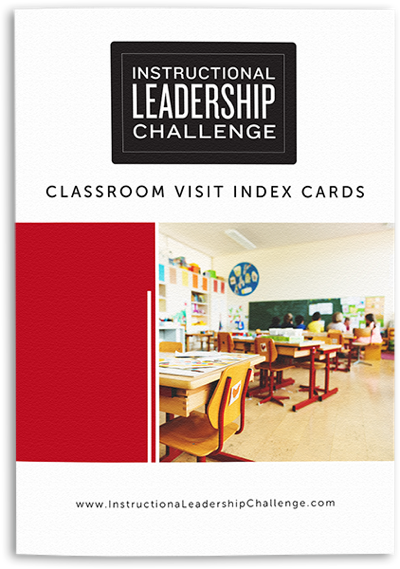
Every school has great things happening—but also has problems lurking in classrooms:
Struggling teachers. Chaotic behavior. Minimal learning. You know the range.
In his management classic Good To Great, Jim Collins says we must “confront the brutal facts” in order to lead effectively.
For school leaders, this means getting into classrooms, and facing the realities we encounter.
If we don't get into classrooms regularly, we will find out about problems the hard way.
The sooner we catch and address a problem, the better:
- Best-Case Scenario: Prevention
- 2nd Best: Catch & address immediately
- 3rd: Catch & address before anyone else notices
- 4th: Wait until it's unavoidable and everyone knows
- Worst: Don't address it at all
Some have suggested that the best way for principals to spend their time is to devote the entire school day—or at least several full days a week—to being in classrooms.
I didn't find that advice realistic or helpful as a principal, and it's not what I advise as an author and consultant. So how often should we get into classrooms?
The Sweet Spot: 15-Walkthrough Weeks
You can't be in every classroom every day. There's simply not time.
Your other non-classroom work is important. Don't let anyone tell you it's not!
So we must balance our need to be in classrooms with our need to accomplish other work during the school day, like meeting with teachers, parents, and students.
I've found the sweet spot to be around 15 classrooms a week.
This comes out to 3 a day, and it means you get around to everyone on a roughly 2-week rotation, depending on how many teachers you supervise.
(If you have multiple administrators on your team, each person should focus on the teachers they personally evaluate.)
With a 2-week rotation, problems don't have time to fester.
You can spot them early and start taking action.
Too often, though, we dread the action that we may need to take, so we avoid getting into classrooms.
We don't feel like we have the bandwidth to deal with the problems we'll uncover, so why go looking for trouble? Let's talk about it.

Solving Problems Takes Time
Why open a can of worms when there's plenty of other work to worry about? Let's make an important distinction:
You don't have to accept the status quo to “confront the brutal facts.”
Improving teacher practice, student behavior, and school operations is often long-term work.
So don't tell yourself “If I see a problem, I'll have to fix it today.”
You don't have time, and couldn't fix all problems in one day even if you did.
But that work can't begin until you know about it.
Your immediate action item is simply find out about the problems that are lurking classrooms, and start to get curious about them.
You'll figure out what to do in good time—but it all starts with knowing.
And that means classroom walkthroughs.
Most administrators barely do any classroom walkthroughs, despite believing they should. At best, they get into each classroom about once a year.
We have leaders on the Classroom Walkthrough Scoreboard who are racking up 15-visit weeks consistently—which means they'll see every teacher 15+ times a year.
They are not super-humans working in cake-walk schools.
They're overworked human beings just like you, who face real challenges.
What they have is a plan—a plan that tells them what to focus on, and what to stop worrying about, so they can get into 15 classrooms a week.
A Plan for Ramping Up In 3 Cycles
A good plan for approaching classroom walkthroughs is to ramp them up in three phases or cycles:

Get the Classroom Walkthrough Tracker by taking the Instructional Leadership Challenge »
In your first round of visits, don't take any notes or give any feedback. Just show up with a smile on your face and stay for a few minutes, with the goal of being present and pleasant.
In your second cycle, visit teachers in the same order. Pay closer attention, and chat briefly afterward, to show that you're interested in what teachers are doing, but don't give any critical feedback or take notes.
In your third cycle, you can start taking notes, and as long as you're sharing them with the teacher immediately, this shouldn't cause undue stress, because you've worked up to it.
A simple way to keep track of your visits is with our free Classroom Visit Index Cards template.
Learn more in our Classroom Walkthrough FAQ »
Have other questions? Leave a comment.
Leave a comment below if you have other questions about classroom walkthroughs.
About the Author
Justin Baeder, PhD is Director of The Principal Center, where he helps senior leaders in K-12 organizations build capacity for instructional leadership.

A former principal in Seattle Public Schools, he is creator of the Instructional Leadership Challenge, which has helped more than 10,000 school leaders in 50 countries around the world:
- Confidently get into classrooms every day
- Have feedback conversations that change teacher practice
- Discover their best opportunities for school improvement
Dr. Baeder is the author of Now We're Talking! 21 Days to High-Performance Instructional Leadership, and the co-author, with Heather Bell-Williams, of Mapping Professional Practice: How to Develop Instructional Frameworks to Support Teacher Growth (Solution Tree).
He is the host of Principal Center Radio, a podcast featuring education thought leaders, and the founder of Repertoire, the professional writing app for instructional leaders.
He holds a PhD in Educational Leadership & Policy Studies from the University of Washington and an MEd in Curriculum & Instruction from Seattle University, and is a graduate of the Danforth Program for Educational Leadership at UW.


